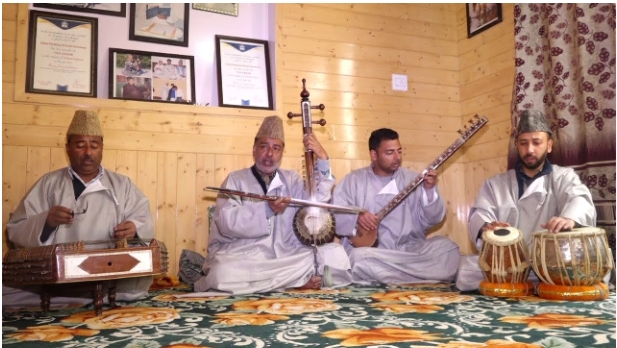Kashmiri Sufi Music: Harmony, Spirituality, and Cultural Legacy in Melodies
Deep lyrics and beautiful melodies have made Kashmiri Sufi Music a major cultural and spiritual force in the Kashmir Valley for a very long period of time. Based in the mystical Islamic religious system of Sufism, which aims to discover heavenly love and understanding by direct personal experience of God, this music genre goes beyond simple amusement. It reflects the rich, resonant spirituality of the area and functions as a channel for spiritual expression and social harmony.
You could explore some of the preserved history while exploring Kashmir Holiday Packages for yourselves. One of the best times to visit Kashmir is in May and one of the best places to visit in Kashmir in May is the Dal Lake, which is easily accessible for all visitors due to the fleeting winter.
Early Origins and Development
The Sufi saints, or “Pirs,” introduced their teachings and musical traditions to Kashmir in the fourteenth century, and Kashmiri Sufi music first emerged into existence. The area offered a rich environment and serene beauty that made these ethereal concepts thrive. A key idea in the Sufi tradition is “Wahdat al-Wujud,” or the Unity of Being, which stresses the divine’s presence in all spheres of existence. This concept permeates Kashmiri Sufi music deeply.
A means of disseminating their teachings was music by the early Sufi missionaries. They created a special fusion that spoke to the Kashmiri people by adjusting Persian and Central Asian musical components to local tastes. The evocative poetry of the Sufi saints was accompanied by instruments like the Noet, a traditional drum, Rabab, a lute-like instrument, and Santoor, a kind of hammered dulcimer, which established standards in this genre.
Significance in Spiritual Life
Kashmiri Sufi Music is fundamentally about the “Ruhaniyat,” or spirituality, that it expresses. Many times derived from the poetry of well-known Sufi poets like Shams Faqir, Sheikh Noor-ud-din Noorani, and Lal Ded, the lyrics address issues of human sorrow, divine love, and the search for truth. These songs are intended to evoke a spiritual reaction in the performer as well as the listener; they are not merely creative expressions.
Fundamental to the Sufi musical experience is the practice of “Sama,” or spiritual listening. Music is a means of achieving a condition of spiritual rapture and intimacy with God during Sama sessions. Combining the profound, philosophical lyrics with the repeating, rhythmic patterns of the music, participants are able to enter a meditative state that helps them transcend the ordinary and make contact with the divine.
Influence Culturally and Social Harmony
Promotion of societal cohesiveness and harmony in the Kashmir Valley has been greatly aided by Kashmiri Sufi Music. Sufi music has remained a unified force in the area despite its stormy past and varied theological landscape. It cuts across denominational lines to unite people from many origins and beliefs in a common spiritual and cultural enrichment experience.
Prime illustrations of this bringing together power are the yearly Urs celebrations, which honour the death anniversaries of Sufi saints. People from many walks of life are drawn to these events to celebrate with music, dance, and group meals. The inclusive character of these gatherings promotes respect and a sense of community among the participants.
Elements and Structure of Music
Though it has unique local flavours, the foundation of Kashmiri Sufi Music is firmly based in classical Indian music traditions. Similar to the Indian Raga system, the “Maqam” system defines the compositions’ melodic structure. Every Maqam is linked to particular moods and periods of the day, which gives the musical experience yet another level of complexity.
Rhythmically, Kashmiri Sufi Music uses complex “Talas,” or rhythmic cycles, performed on traditional percussion instruments like the Tabla and the Noet. The way that the melodic and rhythmic components interact produces an engaging and dynamic musical tapestry that enthrals the listener.
Using call-and-response rhythms, in which a lead vocalist delivers a poetry line and the chorus reacts, is one of the distinctive features of this music. This participatory approach highlights the lyrical substance and strengthens the social element of the performance, therefore increasing its effect.
Leading Artists and Their Works
Many musicians have added over the ages to the rich heritage of Kashmiri Sufi music. Ghulam Hassan Sofi is the most imposing of them all. Recognised for his profound grasp of Sufi philosophy and emotional performances, Sofi’s music never fails to uplift and impact listeners. His compositions capture the core of Sufi mysticism by frequently exploring themes of love, grief, and the never-ending search for God.
Rashid Hafiz is another well-known person, whose efforts have been crucial in preserving the custom in the modern era. Hafiz makes Sufi music approachable to new generations by fusing ancient aspects with contemporary perspectives. With the Santoor and Rabab accompanying his readings of traditional Sufi poetry, listeners of all ages find a timeless quality.
Conclusion
With its deep spiritual foundation and rich cultural legacy, Kashmiri Sufi music is a way of life as much as a musical tradition. For all who experience it, its melodies profoundly capture the essence of divine love, human longing, and the never-ending search for truth. This music is proof of the power of faith and art in a society too frequently split by differences.
We ensure that next generations may benefit from the transforming power of Kashmiri Sufi Music and we also honour the legacy of the Sufi saints who brought this tradition to life by celebrating and preserving it. Reminded of the timeless reality that music, in its purest form, is a conduit to the holy, a source of comfort, and a ray of hope in times of upheaval, we listen to the melancholic melodies of the Santoor and the poignant words of the Sufi poets.
